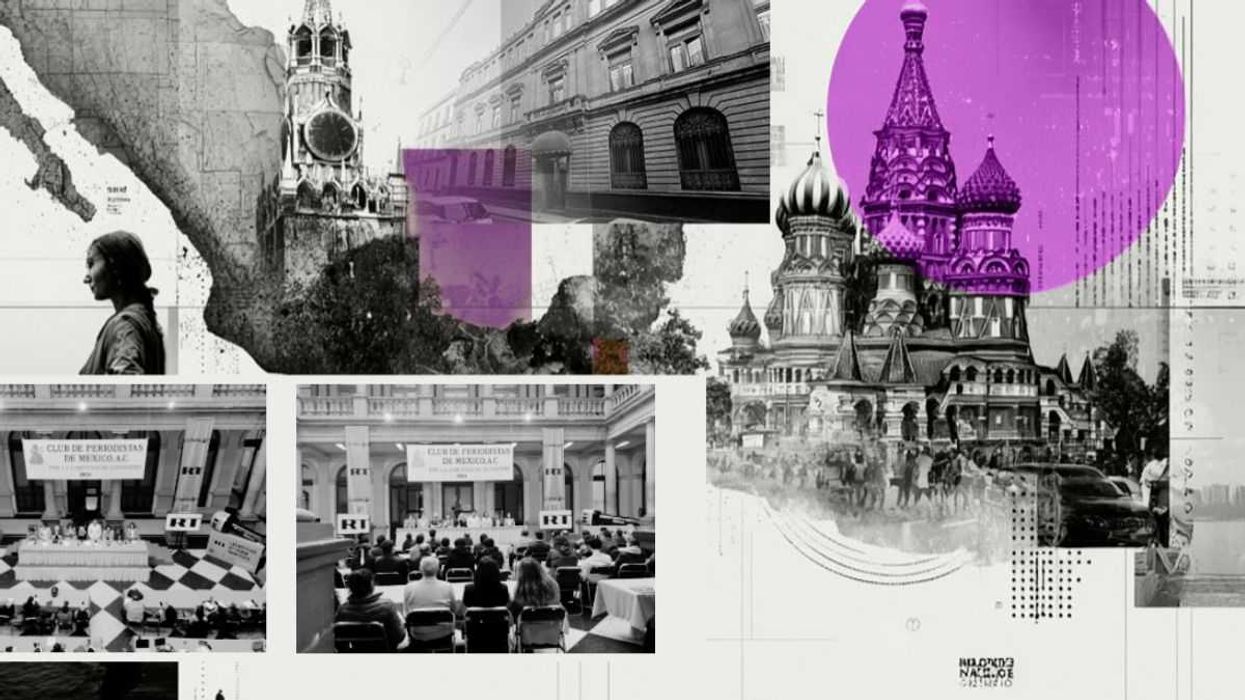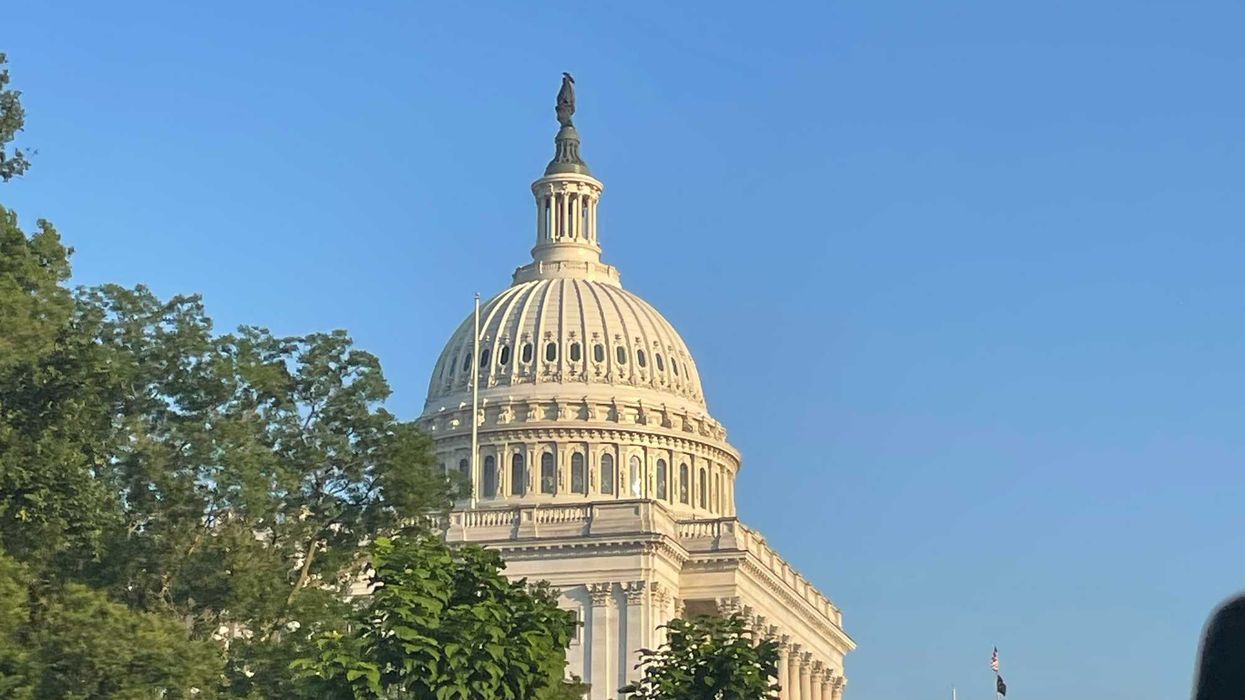Fair Districts GA is a nonpartisan organization that works to end electoral map rigging in Georgia. Our focus is to fight gerrymandering, the practice of drawing legislative district lines to favor one group over another. Our ultimate goal is to reform Georgia's process for drawing state and federal electoral maps. Georgia's current redistricting system gives lawmakers broad leeway to draw district maps for Congressional, state senate, and state house seats. Fair Districts GA supports stronger standards and a nonpartisan, transparent, accountable redistricting process. We collaborate with advocacy groups and grassroots organizations to inform Georgians about gerrymandering, advocate for redistricting reform legislation, and engage concerned citizens in our cause.
Site Navigation
Search
Latest Stories
Start your day right!
Get latest updates and insights delivered to your inbox.
Top Stories
Latest news
Read More
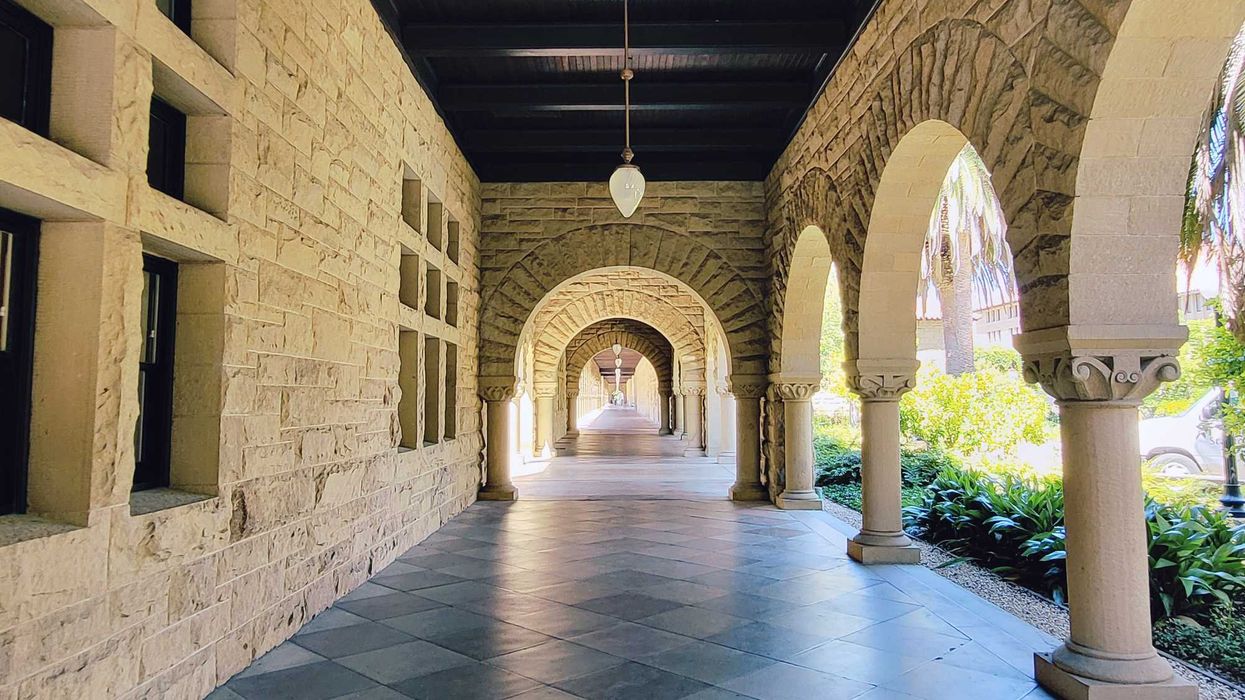
Getty Images, tc397
Federal Funding Cuts Are Only One Problem Facing America’s Colleges and Universities
Dec 10, 2025
Higher education is under stress. The highest-profile threat has been the Trump administration’s efforts to cut funding to several universities, including Harvard, Columbia and Northwestern.
Research universities heavily depend on federal money to conduct research and carry out other areas of work. For example, after tuition, federal money allocated for research made up 40% of the total revenue for two major research universities – Johns Hopkins University and Massachusetts Institute of Technology – in the 2022-23 academic year.
Since January 2025, the Trump administration has terminated various federal grants for universities valued between US$6.9 billion and $8.2 billion.
While there’s been a lot of public attention to the federal government’s financial pressure on universities, universities have been experiencing financial pressure from other sources.
Understanding that is key for applicants and parents to understand their bargaining position when choosing whether and where to pursue a college degree.
As scholars of public administration and economics and former university administrators, we think parents and college applicants need to understand this economic landscape to make smart choices about making such a major investment. Here are four key things to know.
1. Universities are an industry
Most American private colleges and universities are nonprofits, but they still care about revenue. These schools aren’t responsible to shareholders, but they may respond to pressure from alumni, students, employees, donors, boards, the federal government and, if the schools are public universities, state governments.
And like businesses, nonprofit colleges and universities need money. As a result, despite what you might think, most colleges are not particularly selective. Though they don’t advertise that fact, hundreds of schools will take any student who meets minimal academic requirements and can pay tuition.
The added cost of teaching additional students is minimal when there are empty seats, so admitting more students can lead to an increase in revenue for most schools.
This is important because colleges’ costs – largely staff salaries and building maintenance – are hard to cut and are mostly fixed. Those costs must be spread across fewer students when there are unfilled seats.
As the number of people who go to college is declining, colleges need to respond to people’s skepticism about the value of degrees – but change is difficult
Becoming a smaller school is challenging. If students show less interest in foreign language study and more interest in data science classes, the school cannot have a German language professor suddenly teach data science.
As a result, colleges can become stuck with faculty who teach course students don’t want to take.
Unlike business leaders, who may be rewarded for fixing a failing company by laying off workers, university leaders who eliminate faculty positions become unpopular among their peers. This can reduce their chance to advance their careers at their current universities or switch to a new school.
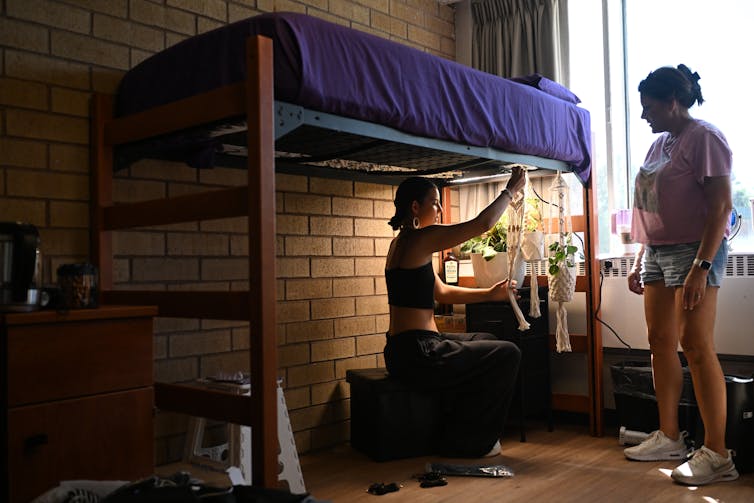 A college freshman gets her new dorm room ready with her mother at Colorado State University in Fort Collins, Colo., in August 2025. RJ Sangosti/MediaNews Group/The Denver Post via Getty Images
A college freshman gets her new dorm room ready with her mother at Colorado State University in Fort Collins, Colo., in August 2025. RJ Sangosti/MediaNews Group/The Denver Post via Getty Images2. Schools have to work to admit students
Colleges enrolled 8.4% fewer students in 2024 than when attendance peaked at 21 million in 2010. As a result, schools must increasingly compete harder to attract students.
One way is to offer a better price, meaning lower tuition. Like most elite schools, Harvard has a listed price of about $60,000 for tuition alone in one academic year – and nearly $87,000 when food, housing and other services are included. Few students actually pay that amount, though the exact percentage getting a discount is not public information.
The average net price a Harvard student paid in 2023-24 was $17,900, as colleges offered either financial aid, straight-up discounts or scholarships.
Most schools engage in this sort of price discrimination, the term economists use to describe charging different prices to different customers based on their willingness to pay. In some ways, this is much like airlines selling seats on the same flights at different prices.
3. Schools have a declining foreign customer base
Another enrollment remedy for colleges and universities to boost tuition revenue has been focusing on admitting international students, who typically pay full price.
One-fourth of all international students in the U.S. come from China, while another quarter come from India.
Most schools have not pursued this strategy of expanding foreign enrollment as aggressively as Columbia University, where international students approach 40% of the student body.
By comparison, international undergraduate students made up 6% of Columbia’s undergraduate student population in 2000, and 12% in 2011.
But the revenue that international students generate is not a guarantee. Foreign student enrollment declined 17% from fall of 2024 to 2025.
In part, that’s because of some students’ inability to get a visa or fear their authorization to study in the U.S. will be revoked.
Rising competition from universities in Australia, Canada and the United Kingdom, combined with stricter U.S. visa policies and geopolitical tensions with China, have led to rapid declines in Chinese students enrolling at American schools.
The number of Chinese undergraduate and graduate students attending U.S. colleges and universities has dropped from 317,299 in 2019 to 265,919 in the 2024-25 school year.
This change has increased the financial strain on American colleges and universities, many of which have grown accustomed to having large numbers of international students who pay their own way.
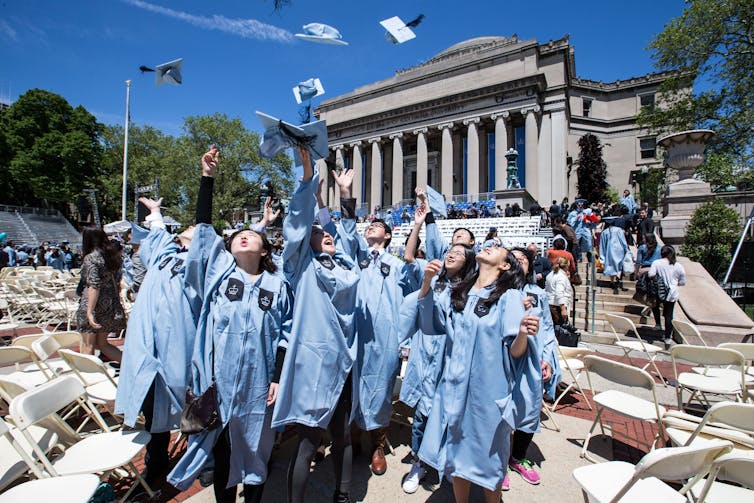 Chinese graduates throw their hats into the sky at their graduation from Columbia University in May 2016. Xinhua/Li Muzi via Getty Images
Chinese graduates throw their hats into the sky at their graduation from Columbia University in May 2016. Xinhua/Li Muzi via Getty Images4. The value of the product is in question
With recent changes to federal loan forgiveness programs, some students and their parents are questioning the value of a college degree.
Just 22% of Americans said in 2024 that a college degree is worth the cost, if a student has to borrow money to get it.
The University of Texas system – made up of nine universities and four medical schools – shares information on the average income of graduates for every degree program after graduation.
In the case of the University of Texas at Arlington, the average salary for a drama, theater arts and stagecraft major is $14,933 one year after graduation. This amount goes up to $39,608 10 years after graduation, resulting in a negative $324,210 return on the price of college over that first decade.
Of course, some degrees pay off. A University of Texas at Arlington graduate with a degree in civil engineering earns an average of $67,920 one year after college and $105,377 10 years after graduation, demonstrating a positive return on investment of $1.15 million.
We believe that universities and colleges should reform to address the next generation’s uncertainty about higher education.
College applicants should be asking hard questions. What is the data on graduates’ earnings compared to the cost of their program? Where are graduates employed?
If more people treated buying a college degree with the same care they use to buy their first home – an equivalent investment – colleges and universities would feel pressure to become more transparent for students and parents. They would also become more aligned with the rapidly evolving demands of the workplace.
Federal Funding Cuts Are Only One Problem Facing America’s Colleges and Universities was originally published by The Conversation and is republished with permission.
Keep ReadingShow less
Recommended
Workshops, Street Promotions and Alleged Covert Operations: Russian Propaganda in Latin America
Dec 10, 2025
Amid political unrest ahead of Mexico’s 2024 presidential election —between late 2023 and early 2024—, Russian state media outlet Russia Today (RT) launched a street-level promotional campaign in Mexico City. Posters appeared in Metro and Metrobús stations, encouraging commuters to scan a QR code to watch the channel’s newscasts.
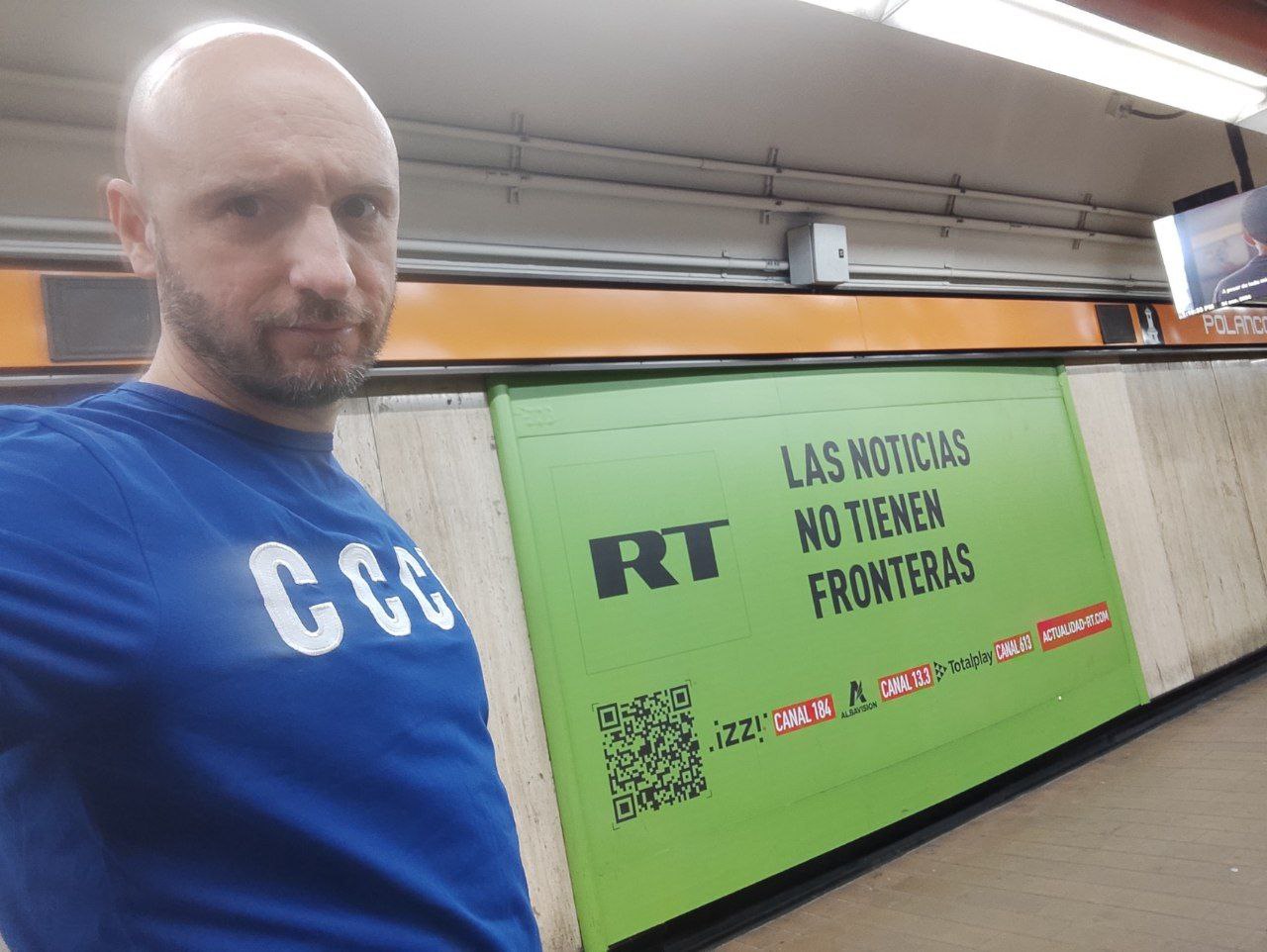
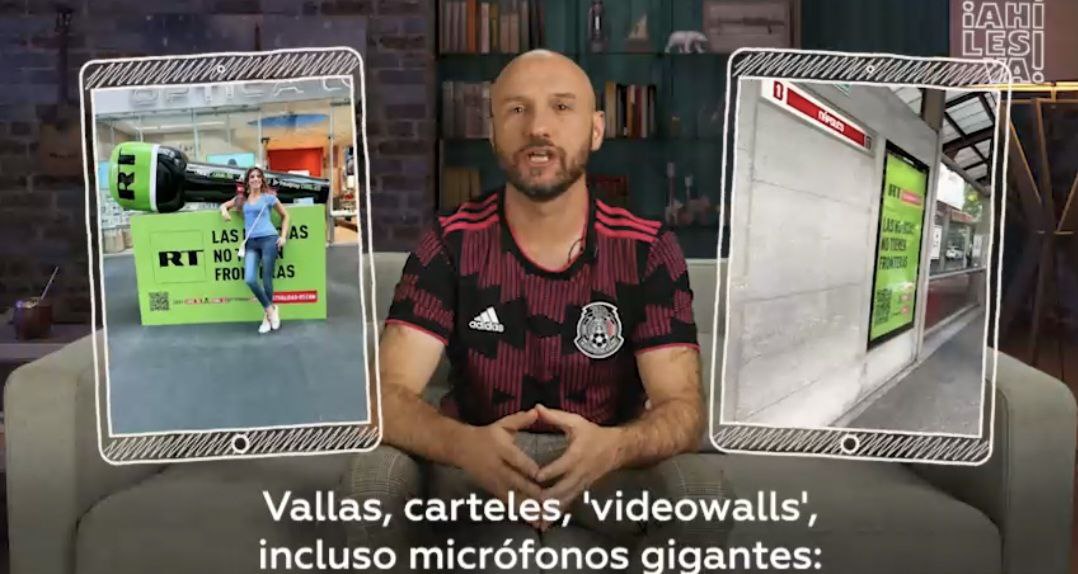
The host of RT’s program Ahí les va also mocked accusations that the channel spreads propaganda on his YouTube show.Photos from the Telegram account “¡Ahí les va!”
The promotion drew scrutiny in Mexican media, which noted that the European Union and companies such as Google had blocked RT for spreading pro-Putin narratives and disinformation about Russia’s invasion of Ukraine, which began Feb. 22, 2022. No similar restrictions were imposed in Mexico. Then-President Andrés Manuel López Obrador publicly opposed limiting access to RT or Sputnik content for Mexican audiences, both owned by the Russian state.
In January 2024, RT held a communications workshop in Mexico City as part of its RT CompaRTe initiative. According to the channel, over the past three years, the program has held training events in at least eight Latin American countries: Mexico, Argentina, Colombia, Venezuela, Nicaragua, Cuba, Guatemala, and Panama.
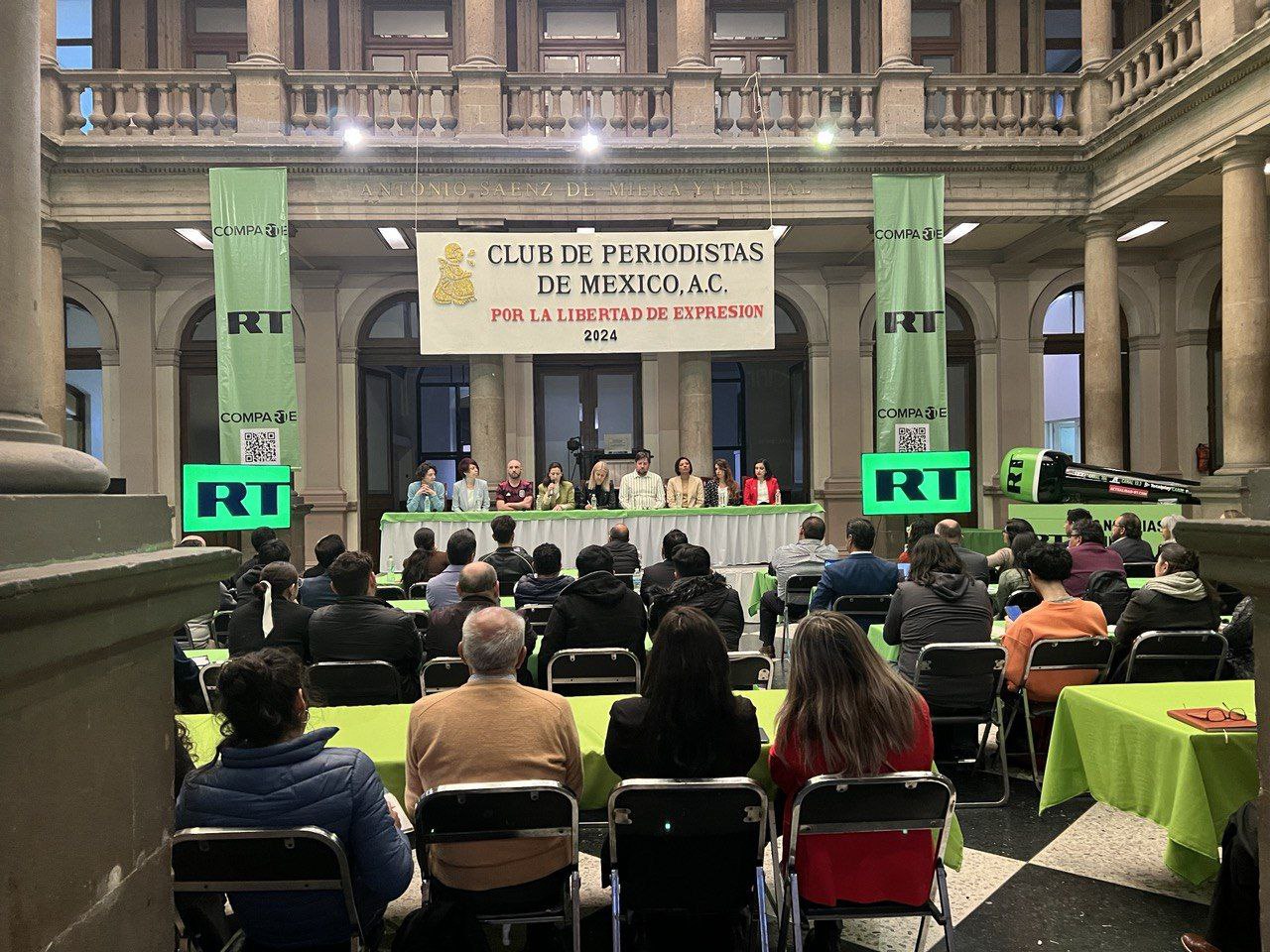

The Club de Periodistas de México, which hosted the workshop, told Factchequeado that “the spaces for RT were completely free,” that the courses were free for participants, and that panelists received no compensation. “No fees were charged to participants. In fact, we provided coffee and a modest buffet, covered by the Club de Periodistas de México,” the organization said.
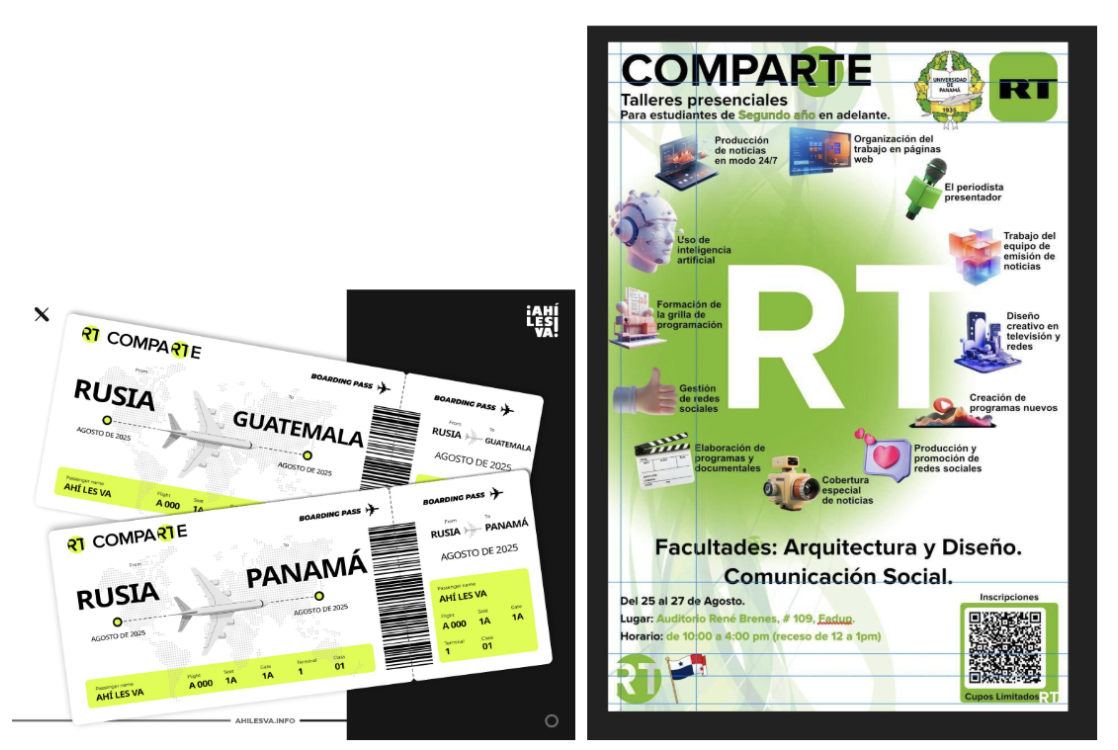
The Mexico City workshop covered topics including source management, “broad perspective topic research,” artificial intelligence, and even fact-checking. RT says more than 1,000 journalists and media workers from Latin America have participated in its workshops and exchange programs since RT CompaRTe began.
Venezuelan fact-checking outlet Cazadores de Fake News, a member of the LatamChequea network like Factchequeado, reported that at a workshop in Venezuela attended by journalists sympathetic to the government, participants shouted “¡Viva Rusia!” and “¡Viva Putin!” at the end of the sessions. This took place in the presence of channel executives and the Russian ambassador in Caracas, Sergey Melik-Bagdasarov.
In Mexico City, the RT workshop was held at the Club de Periodistas, led by Celeste Sáenz de Miera, a communications professional who promotes pro-Russian narratives online and coordinates the annual Certamen Nacional e Internacional de Periodismo. RT in Spanish and its journalists have been recurring winners of the award. When Izzi, a major Mexican cable network owned by Televisa, began broadcasting RT in 2016, the channel celebrated receiving the “prestigious international award from the Club de Periodistas de México” for the third consecutive year.
Factchequeado reached out to RT for comment but did not receive a response before publication.
RT’s Reach in the Region
RT says its Spanish-language content currently airs in 18 Latin American countries, including Brazil, Argentina, Bolivia, Ecuador, Paraguay, Honduras, Venezuela, and Cuba. Sputnik, another outlet affiliated with Rossiya Segodnya, Russia’s state-controlled international news agency, also targets Latin American audiences.
In Mexico, at least 81 cable providers carry RT, according to the channel. Izzi removed the channel from its package, but TotalPlay still offers it. Telsusa or Albavisión network broadcasts RT over open digital television, claiming coverage in 15 of 32 Mexican states and a potential audience of 11 million households. In 2024, Telsusa obtained a contract from the Mexican Social Security Institute (IMSS) for 1 million pesos, with reference number 050GYR019N05824-008-00, to broadcast institutional campaigns, and in 2023 signed a 2 million-peso contract with the Fondo Mixto de Promoción Turística de la Ciudad de México.
“Personally, I don’t feel any opposition to RT in any Latin American country. RT has faced challenges in the U.S., Europe, and England, but we are happy, our audience is loyal, and it keeps growing,” said Victoria Vorontsova, RT en Español director, in January during the channel’s Mexico courses. “We are always accused of propaganda, but what we try to do is not propaganda, it’s to tell stories that interest all the peoples of Latin America,” she added.
When critics raised concerns in late 2023 and early 2024 about RT’s street promotions in Mexico City, columnist Mirko Casale, host of Ahí les va, argued that such campaigns were logical in a Spanish-speaking country where the channel’s content had been censored or ignored elsewhere. “RT en Español does not seek to misinform or create chaos, nor to install or remove presidents in the countries where it broadcasts or advertises. Not in Mexico either. Its goal is to provide an alternative perspective on international events and, occasionally, present the Russian state’s viewpoint, which, like any nation’s, matters and has a right to be shared,” Casale said.
“México No Perdona”
The broadcasts and workshops are the public face of Russia’s propaganda efforts. Separately, multiple reports and legal actions allege covert Russian operations aimed at disinformation and polarization in several countries.
In September 2024, the U.S. Department of Justice seized 32 internet domains linked to the “Doppelgänger” operation, in which Russian companies Social Design Agency (SDA) and Structura National Technology (Structura) allegedly cloned government and media websites in multiple countries to spread anti-Ukraine narratives, justify the invasion, and influence voters in events such as the 2024 U.S. presidential election.
“As alleged in our court filings, President Vladimir Putin’s inner circle, including Sergei Kiriyenko, directed Russian public relations companies to promote disinformation and state-sponsored narratives as part of a campaign to influence the 2024 U.S. Presidential Election,” said then-Attorney General Merrick B. Garland.
“An internal planning document created by the Kremlin states that a goal of the campaign is to secure Russia’s preferred outcome in the election. The sites we are seizing today were filled with Russian government propaganda that had been created by the Kremlin to reduce international support for Ukraine, bolster pro-Russian policies and interests, and influence voters in the United States and other countries,” the official document said.
One seized document indicates that SDA included Mexico in its disinformation plans under “Operation México No Perdona” (“Mexico Does Not Forgive”). “The campaign intended to encourage “anti-American sentiment” as well as to exacerbate confrontation between the United States and Mexico. Although the campaign would target Mexico, the campaign’s goal also intended to influence the U.S. Presidential Election,” U.S. authorities said.
Although a direct link to the operation has not been confirmed, Factchequeado and El Sabueso of Animal Político have observed a surge in disinformation about Mexico-U.S. relations since early 2025, including fake accounts impersonating news outlets and journalists using AI-generated identities.
One disinformation post warned, “If the U.S. army sets foot in Mexico, we go to war.” Another falsely attributed statements to President Claudia Sheinbaum and former President Donald Trump regarding U.S. control of southern Mexico’s airspace.
Factchequeado documented how RT and Sputnik spread conflicting narratives in Spanish and English about protests in Los Angeles against migrant raids in June 2025. Spanish coverage criticized Trump’s immigration policies, while English posts suggested the protests were orchestrated by NGOs or George Soros as part of a plot against Trump.
In November 2023, the U.S. State Department warned of a Russian operation exploiting media contacts in Argentina, Bolivia, Chile, Colombia, Cuba, Mexico, Venezuela, Brazil, Ecuador, Panama, Paraguay, Peru, and Uruguay to promote “Russia’s strategic interests in the region.” Russian agencies SDA and Structura and pro-Kremlin journalist Oleg Yasinsky were cited as participants.
In response, Yasinsky published a column on Mexican site desinformemonos.org defending his independence as a Ukrainian and calling the U.S. “the true global propaganda machine,” adding that only a military defeat of Ukraine could “end NATO’s experiment in the heart of Europe.”
Workshops, Street Promotions and Alleged Covert Operations: Russian Propaganda in Latin America was first published on Factchequeado and was republished with permission.
This article is part of our investigation “Putin’s Laundromat.”
Factchequeado is a fact-checking outlet that builds a Spanish-speaking community to counter disinformation in the United States. Want to join? Send the content you receive to our WhatsApp +1 (646) 873 6087 or visit factchequeado.com/whatsapp.
Keep ReadingShow less

AI is transforming how people seek help, share stories, and connect online. This article examines what’s at stake for social media and the future of human connection.
Getty Images, Malorny
What Happens to Online Discussion Forums When AI Is First Place People Turn?
Dec 09, 2025
No doubt social media and online discussion forums have played an integral role in most everyone’s daily digital lives. Today, more than 70% of the U.S. adults use social media, and over 5 billion people worldwide participate in online social platforms.
Discussion forums alone attract enormous engagement. Reddit has over 110 million daily active users, and an estimated 300 million use Q&A forums like Quora per month, and 100 million per month use StackExchange. People seek advice, learn from others’ experiences, share questions, or connect around interests and identities.
In mental health contexts, online peer support communities offer a place to share and disclose personal struggles, hear others’ experiences, and receive social support. Research supports the success of these online communities, which enable people to candidly self-disclose and seek support from others.
When people engage with personal narratives on peer-support sites, they often feel more confident in coping with stressful events. At the same time, these platforms also expose individuals to online trolling, harassment, misinformation, and other antisocial behaviors.
The familiar dynamics of those communities took a turn about three years ago, when conversational AI tools like ChatGPT entered the public sphere and quickly captured widespread attention.
This marked the start of a new era of interactive AI in day-to-day lives and society. People tried recipes, coding help, emotional support, creative writing, and more. The ease of asking a machine a question, receiving a coherent response, and doing so privately sparked a new kind of engagement.
Shortly after ChatGPT’s release, Google issued a “code red,” citing the tool’s rapid adoption as a threat to traditional search behavior and the information-seeking habits that long supported online forums.
At that moment, many wondered, "What is the future of social media and online discussion forums when people increasingly turn to AI instead of each other?"
That question warrants attention because the value of online communities depends on active participation. When fewer users post questions, share responses, or react to others, the foundational mechanisms of online forums—reciprocity, belongingness, narratives of shared experience—become weaker. If a user can ask an AI privately and immediately, the incentive to engage publicly changes.
A recent report by Anthropic warns that AI models can exhibit “natural emergent misalignment,” including reward hacking—where systems learn to game feedback signals in ways humans did not intend. It’s a timely reminder that AI can sound empathetic and coherent without having lived experience or genuine understanding.
However, one of the crucial aspects of a supportive response from a peer is the presence of personal narratives and lived experiences. A systematic review noted that young people in online communities seek both informational and emotional support through stories of peers who have faced similar challenges. This suggests that narrative exchange is not simply transactional—it works when users engage as part of a community of peers, not as isolated speakers into the void.
By contrast, AI lacks lived experience. It can simulate empathy, but it cannot draw from a personal story.
In our research comparing AI-generated responses with peer responses in online communities, AI’s language was more formal, structured, and polite, but it rarely used first-person pronouns (which signal personal narratives).
Even when an AI’s replies appear personalized, they show limited diversity. Across many queries, the AI often reuses the same templates with minor variations. Online communities, in contrast, produce a range of viewpoints. Even a single question elicits diverse stories and perspectives from multiple individuals.
In a new study of teens' use of AI, results show more than 70% of teens have used AI companions, with one-third discussing serious personal issues with them rather than people.
Another survey found that 58% of users think that ChatGPT is “too nice,” and argue that the lack of realistic push-back undermines authenticity. These point to a tension: on the one hand, convenience and immediacy win; on the other, authenticity and narrative connection may suffer.
So what is at stake?
The forms of online social life are evolving. Large general-purpose platforms that once relied on high-volume question-and-answer interactions may see that function increasingly handled by AI. Participation may decline, not because people stop connecting, but because their first step becomes private and AI-mediated.
In that scenario, online community spaces may become more selective, more identity-driven, and oriented toward authentic human experience rather than mechanical problem-solving.
At the same time, platforms may adapt. Many already integrate AI to moderate content, summarize discussions, or help users articulate questions. In the future, AI may become part of the community infrastructure—filtering, guiding, even prompting human interaction, rather than replacing it.
The enduring value will be human presence: the voices of people who have lived the story, the shared recognition of someone else’s struggle, the sense of belonging created when users see that others have walked the same difficult path.
The future of social media, therefore, depends on which interactions people continue to value. Efficiency and convenience will not alone sustain the community. The presence of narratives rooted in human experience, and the recognition that someone else has faced a similar challenge, are what give forums their emotional traction. As AI becomes a more capable first responder, the discussion spaces that thrive will be those that prioritize experience, connection, and mutuality over instant answers.
In this emerging online and digital era, the question is not only whether people will use AI alongside communities—they already do. The more pressing question is how many choose AI instead of online (or offline) communities. The answer will determine not simply which platforms survive, but what form meaningful online connection takes in the years ahead.
The question then becomes, do people really need people?
Dr. Koustuv Saha is an Assistant Professor of Computer Science at the University of Illinois Urbana-Champaign’s (UIUC) Siebel School of Computing and Data Science and is a Public Voices Fellow of The OpEd Project. He studies how online technologies and AI shape and reveal human behaviors and wellbeing.
Keep ReadingShow less
A Lasting Solution to the Gerrymandering War
Dec 09, 2025
Perhaps the late Rep. Sheila Jackson Lee knew what was coming. As an early proponent of a federal bill banning mid-decade gerrymandering, she now appears to have been ahead of her time. Indeed, today, no fewer than seven bills in Congress bear her legacy of concern for fair representation in redistricting. That’s more than any other time in modern congressional history.
The story of the current gerrymandering war flows through her home state of Texas. The legal fight over congressional maps after the 2010 census was complicated; the U.S. Supreme Court struck down several sets of maps as racial gerrymanders.
As a Black member of Congress from Houston, Jackson Lee understood the importance of sponsoring legislation to counteract partisan and racial gerrymanders more than a decade ago. Not long after the U.S. Supreme Court ended preclearance protections in 2013’s Shelby County v. Holder decision, Rep. Jackson Lee introduced the Coretta Scott King Mid-Decade Redistricting Prohibition Act of 2013. The act would have banned states from engaging in congressional redistricting mid-decade, rather than the traditional timeline of redistricting only when new census data is available at the start of each decade.
With that bill, Rep. Jackson Lee sought to prevent the vote dilution of Black and Latino voters who, before the Shelby County decision, had been protected by Sections 4 and 5 of the Voting Rights Act. Those provisions required many jurisdictions with a history of discrimination to obtain federal approval before their new district maps would take effect.
The Jackson Lee bill surely drew inspiration from the Fairness and Independence in Redistricting Act of 2005, introduced by Rep. John Tanner of Tennessee. Unfortunately, the legal playing field regarding redistricting would only get worse: In the 2019 case Rucho v. Common Cause, the Supreme Court removed the federal judiciary from striking down political gerrymanders.
Jackson Lee reintroduced her bill each Congress until she passed away in office last year. A mere 13 months after her death, however, the Texas Legislature passed a new congressional map in the middle of the decade with the explicit intent to engage in racial gerrymandering. This set off a domino effect across the country: Nearly half a dozen states have either passed or taken official steps toward mid-decade redistricting in response.
Both Democrats and Republicans in Congress have taken note of this spiraling mess: To date, at least Rep. Marc Veasey, Rep. Kevin Kiley, Rep. Steve Cohen, Rep. Zoe Lofgren, Rep. Donald Davis, Rep. Vicente Gonzalez, and Rep. Deborah Ross have introduced bills in reaction to, and aiming to control, this year’s unprecedented mid-decade gerrymandering war.
While all these efforts deserve to be commended and supported, they cannot get past the reality that gerrymandering – whether racial or partisan – will continue to blight our democracy so long as we use single-member districts to elect members of Congress. The efforts may constrain or temporarily pause the gerrymandering war, but they won’t solve it.
In contrast, Rep. Don Beyer’s Fair Representation Act – which would enact ranked choice voting with multi-member districts for the U.S. House – would be a lasting solution to our historic spiral of partisan dysfunction. In addition to delivering a more proportional House that would be nearly impossible to gerrymander, the Fair Representation Act includes a ban on mid-decade redistricting.
As we get closer to the 2026 midterm elections, there is no clear end to the gerrymandering wars; rather, they have spilled back into the courts. Texas’s opening move has been ruled a racial gerrymander by a federal district court, in violation of the Voting Rights Act. The Department of Justice has sued California over its proposed new map, alleging that it is a racial gerrymander. The Supreme Court will soon adjudicate these cases in some fashion.
And while no one can predict how the Court will rule, it is hard to see a resolution that delivers fairer and better representation for We the People. As Rep. Sheila Jackson Lee knew, along with those following in her footsteps on both sides of the aisle, It doesn’t have to be this way.
Ryan J. Suto is the Senior Policy Advisor at FairVote, a nonpartisan organization seeking better elections for all.
Keep ReadingShow less
Load More















